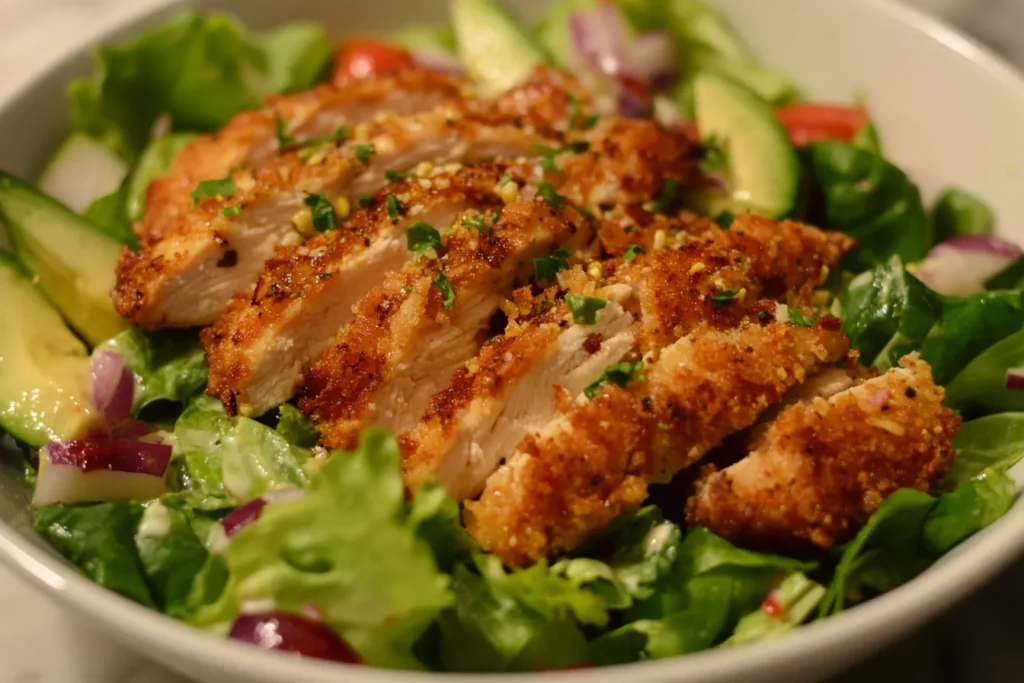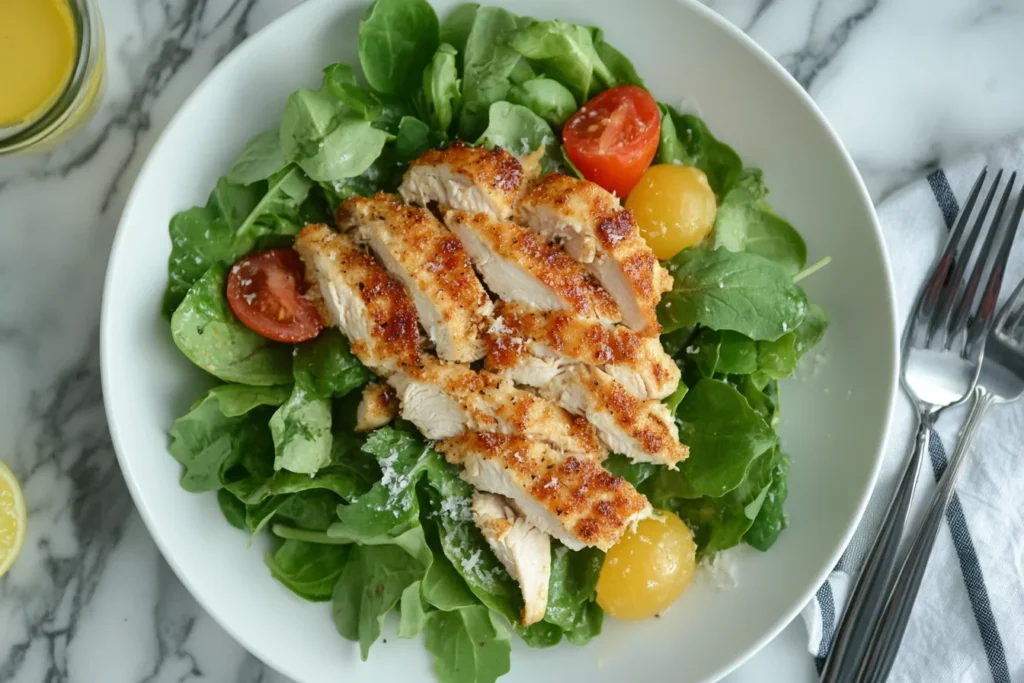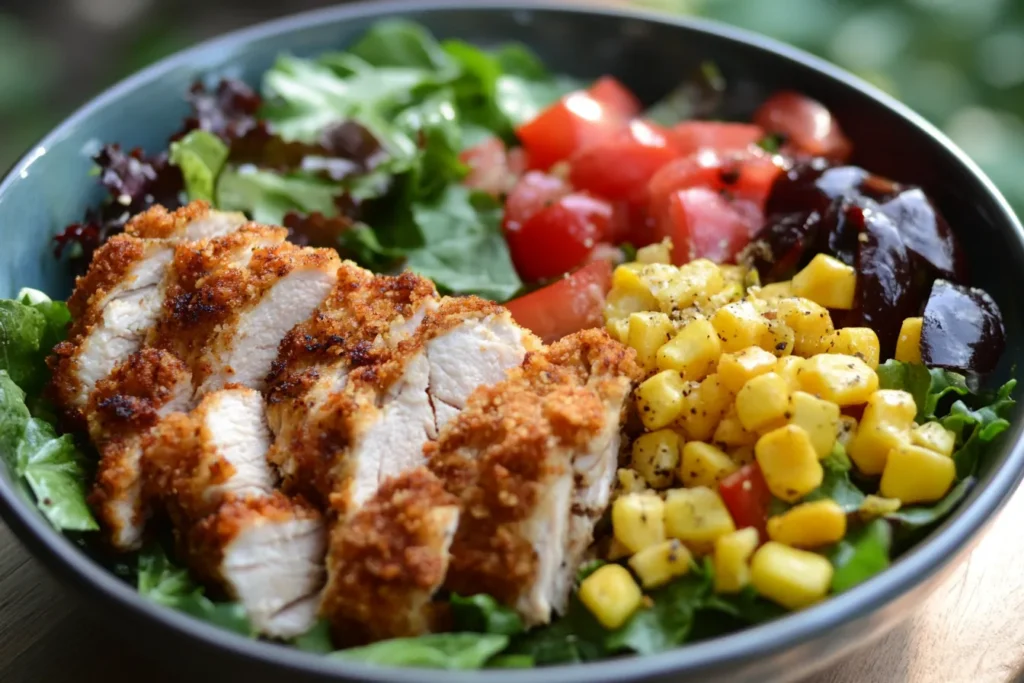Are you tired of the same old boring salads that leave you feeling unsatisfied? Let’s change that! Imagine a crispy chicken salad that’s not only bursting with flavor but also perfectly balanced with crunch, freshness, and a touch of indulgence. Whether you’re looking to jazz up your lunch routine or impress your family with a quick, delicious dinner, this salad has got you covered. It’s the perfect solution for those cravings when you want something healthy but also crave the satisfaction of a hearty, crispy bite. Ready to dive into a salad that speaks to you? Let’s get started!
List Of Contents
Understanding the Basics of Crispy Chicken
Who doesn’t love biting into a piece of perfectly crispy chicken? That delightful crunch followed by tender, juicy meat is a universal favorite. But achieving that crispy perfection at home can be a challenge if you don’t know the tricks of the trade. Let’s uncover the secrets behind making your chicken irresistibly crispy. Check out more recipes here.

What Makes Chicken Crispy?
The hallmark of crispy chicken lies in the interplay between moisture, fat, and coatings. When chicken hits hot oil or an oven, moisture in the outer layers quickly evaporates, leaving a crackly, crunchy texture. A few critical factors that contribute to this transformation include:
- Moisture management: Too much water on the surface can steam the chicken rather than crisp it.
- The right coating: Flour, cornstarch, and breadcrumbs all play specific roles.
- Proper cooking techniques: Even small errors in temperature or timing can ruin the texture.
Achieving the perfect crisp isn’t just about frying—temperature control and proper seasoning elevate the process into an art form. Check out more recipes here.
The Role of Temperature in Achieving Crispiness
Temperature is the backbone of crispy chicken success. If the oil is too hot, the outside burns before the inside cooks. If it’s too cold, the coating absorbs oil, resulting in a soggy, greasy mess. Here’s why maintaining the right temperature is crucial:
- Ideal frying temperature: Between 325°F and 375°F.
- For baking: Preheat your oven to 400°F or higher, depending on the recipe.
- Air fryers require precision, often around 375°F, for consistent results.
Using a thermometer can eliminate guesswork, ensuring you’re always in the sweet spot. Check out more recipes here.
Different Methods for Cooking Crispy Chicken
There’s no single way to achieve crispy chicken bliss. Each method offers its own advantages depending on your preferences and health goals.
Frying: The Classic Approach
Deep frying is the gold standard. The hot oil locks in flavor while creating a crunchy exterior. However, achieving consistent results requires:
- A deep fryer or heavy-bottomed pan.
- Enough oil to fully submerge the chicken pieces.
- Close attention to cooking times.
Looking for delicious dinner ? Check out more recipes here.
Baking for a Healthier Option
Baking uses less oil and can still deliver great results when done right:
- Coat chicken in a light layer of oil or butter.
- Use a wire rack to allow hot air to circulate evenly.
- Opt for breadcrumbs or panko for added crunch.
Air Frying: A Modern Twist
Air fryers combine the health benefits of baking with the crispiness of frying. Hot air mimics the effect of oil frying, and it’s perfect for small batches. For best results:
- Avoid overcrowding the basket.
- Lightly spray the chicken with cooking oil.
- Flip halfway through for even crisping.
Key Ingredients for Crispy Chicken
The right ingredients make all the difference. While chicken is the star, the supporting cast of flour, seasonings, and enhancers play vital roles.
The Importance of Flour and Coatings
The outer coating determines how crispy the chicken becomes. Flour, breadcrumbs, and panko are popular options:
- All-purpose flour: A classic base.
- Cornstarch: Adds extra crispiness when mixed with flour.
- Breadcrumbs or panko: Deliver crunchier textures, especially for baked chicken.
Choosing the Right Seasonings
Seasonings elevate crispy chicken from good to great. Popular choices include:
- A simple mix of salt, black pepper, garlic powder, and paprika.
- Herbs and spices like thyme, cayenne, or smoked paprika for added complexity.
Using Cornstarch and Baking Powder
Cornstarch and baking powder are secret weapons for enhancing crispiness. Cornstarch creates a smooth, even layer, while baking powder reacts during cooking to create bubbles in the crust, resulting in a light, airy texture. Check out more recipes here.
Techniques to Enhance Crispiness
Achieving perfectly crispy chicken goes beyond just the cooking method. The preparation and execution of specific techniques can make or break the texture and taste. Let’s delve into the proven methods that ensure your chicken has that irresistible crunch every time. Check out more recipes here.
Preparing the Chicken for Maximum Crispiness
Preparation is key to creating crispy chicken. The way you handle your chicken before cooking can significantly affect the final outcome.

Proper Washing and Drying Techniques
A common mistake is neglecting the drying process. Water on the surface of the chicken can prevent the coating from sticking properly and lead to uneven crispiness. Follow these steps:
- Rinse the chicken lightly (if preferred), then pat it completely dry with paper towels.
- Let the chicken air-dry in the fridge for 30–60 minutes. This step reduces surface moisture, ensuring better adherence of the coating.
Marination: The Foundation of Flavor and Texture
Marination isn’t just about flavor—it also tenderizes the meat and sets the stage for crispiness. A buttermilk marinade is particularly effective:
- Why buttermilk? Its acidity tenderizes the chicken, while its thick texture helps the coating cling better.
- Add seasonings like garlic, paprika, or cayenne to the marinade for a flavor-packed punch.
Marinate the chicken for at least 2 hours, but overnight is ideal for deeper flavor absorption.
The Double-Coating Technique
A double-coating technique guarantees a crunchier exterior. This method involves layering the chicken twice with your chosen coating.
First Coat: Locking in Moisture
- Dip the chicken pieces into seasoned flour or a mix of flour and cornstarch.
- Lightly press the coating onto the chicken to create an even base layer.
Second Coat: Sealing the Crunch
- Dip the floured chicken into a liquid (buttermilk or egg wash).
- Coat it again with a fresh layer of flour or breadcrumbs for maximum crunch.
The double-coating seals the chicken’s moisture and creates a thicker, more textured crust.
The Secret to Perfect Oil Temperature
When frying chicken, the oil temperature is critical. Too hot, and your chicken burns on the outside while remaining undercooked inside. Too cool, and the crust becomes soggy with absorbed oil.
Maintaining a Consistent Heat
Consistency is everything when it comes to frying. Use these tips to maintain the right oil temperature:
- Use a kitchen thermometer to monitor the oil. Aim for 350°F–375°F.
- Avoid overcrowding the pan, as this drops the oil temperature.
- Allow the oil to reheat between batches.
Best Oils for Frying Chicken
Choosing the right oil impacts both flavor and texture. Ideal oils have high smoke points and neutral flavors:
- Vegetable oil: A classic choice.
- Peanut oil: Adds a slight nuttiness without overpowering the chicken.
- Canola oil: Affordable and effective.
Tips for Baking Crispy Chicken
Baking offers a healthier alternative to frying, but the challenge lies in achieving comparable crispiness. These tips ensure success:
Using a Wire Rack for Even Cooking
- Position the chicken on a wire rack placed atop a baking tray..
- This setup allows hot air to circulate, ensuring even crispiness on all sides.
- Grease the rack lightly to prevent sticking.
Preheating the Oven to Ensure Crispness
- Always preheat the oven to at least 400°F.
- A preheated oven ensures the coating crisps immediately rather than turning soggy from a slow temperature rise.
For even better results, brush the chicken with a thin layer of oil or melted butter before baking.
Air Frying: Modern Convenience with Crisp Results
The air fryer has revolutionized crispy chicken preparation. To master this method:
- Preheat the air fryer for 3–5 minutes.
- Arrange chicken pieces in a single layer to allow hot air to circulate.
- Gently coat the chicken with a mist of cooking oil to boost its crispiness..
Flip the chicken halfway through cooking to ensure even browning and crunch.
Troubleshooting and Expert Tips
Even the most experienced cooks encounter challenges when preparing crispy chicken. Understanding common mistakes and advanced techniques can help elevate your dish from good to truly spectacular. Let’s explore how to troubleshoot issues and master the art of crispy chicken.
Common Mistakes That Ruin Crispy Chicken
Even minor missteps can compromise the texture and flavor of your chicken. Avoid these pitfalls to achieve consistent results.

Overcrowding the Pan
When frying, placing too many pieces in the pan can:
- Lower the oil temperature, resulting in soggy chicken.
- Prevent even cooking due to restricted airflow.
Solution: Fry in small batches, allowing each piece enough space to crisp properly.
Using Wet Coatings Ineffectively
A wet or improperly mixed coating leads to uneven textures. Signs of this issue include:
- Thick, gummy patches on the crust.
- Coating that falls off during cooking.
Solution: Ensure your coating ingredients are evenly mixed and the chicken is well-dried before applying.
Inadequate Drying of Chicken Pieces
Excess moisture on chicken prevents the coating from adhering and can cause splattering during frying.
Solution: Pat the chicken thoroughly dry and let it air-dry in the fridge before seasoning or coating.
How to Keep Fried Chicken Crispy Longer
The crispiness of freshly fried chicken can fade quickly. Here’s how to maintain that crunch even after cooking.
Best Practices for Storing Leftovers
If you need to store leftover chicken:
- Place it in an airtight container with paper towels to absorb moisture.
- Keep it refrigerated for up to two days.
Avoid sealing the chicken while it’s still hot, as trapped steam will make the crust soggy.
Reheating Techniques That Retain Crispiness
Reheating fried chicken often results in a chewy crust or dried-out meat. To reheat properly:
- Preheat your oven to 375°F.
- Arrange the chicken on a wire rack positioned above a baking sheet.
- Heat for 10–15 minutes, flipping halfway through.
For small portions, an air fryer is an excellent tool to restore crispiness.
Advanced Tips for Crispy Chicken Perfection
After mastering the fundamentals, try these advanced techniques to elevate your crispy chicken skills.
Infusing the Coating with Unique Flavors
Try incorporating various ingredients to enhance the flavor and texture of your crust:
- Mix breadcrumbs with grated Parmesan cheese or finely crushed nuts to boost flavor and add a unique texture.
- Mix herbs like oregano or rosemary into your coating.
- Try adding spices such as cumin or turmeric for a global twist.
Pairing Crispiness with Dipping Sauces
Choosing the perfect dipping sauce can enhance the flavor of crispy chicken and take it to the next level. Popular pairings include:
- Southern-style chicken: Honey mustard or spicy barbecue sauce.
- Asian-inspired chicken: Sweet chili sauce or soy-based dips.
- Mediterranean flavors: Tzatziki or garlic aioli.
Experimenting with Global Techniques
Different cultures offer unique takes on crispy chicken:
- Korean Fried Chicken: Uses a thin, double-fried crust with a sweet-and-spicy glaze.
- Southern Fried Chicken: Known for its thick, seasoned buttermilk crust.
- Japanese Karaage: Marinate the chicken in soy sauce and sake, then coat it with potato starch to achieve a delicate, crispy texture.
Integrating these techniques into your routine brings diversity and creativity to your cooking.
Conclusion: Achieving Crispy Chicken Excellence
Mastering the art of crispy chicken requires attention to detail, the right ingredients, and patience. Whether you’re frying, baking, or air-frying, the secrets outlined here will guide you to success.
Would you like help with any specific recipe or additional resources on crispy chicken?
FAQs
1. What’s the best oil for frying crispy chicken?
Peanut oil and vegetable oil are ideal due to their high smoke points and neutral flavors.
2. Can I make crispy chicken without frying?
Yes, baking and air frying are healthier alternatives that still deliver crunch.
3. Why does my chicken coating fall off?
This is usually due to wet chicken or an improperly adhered first coating. Always dry the chicken thoroughly before coating.
4. How do I make gluten-free crispy chicken?
Replace traditional flour with gluten-free options such as rice flour or almond flour.
5. Is cornstarch better than flour for crispiness?
Cornstarch adds extra crispiness when mixed with flour in the coating.
6. Is it possible to use frozen chicken for crispy dishes?
Yes, but make sure to fully thaw it and dry it thoroughly to eliminate any excess moisture.
7. What’s the secret to crispy baked chicken?
Place the chicken on a wire rack, preheat the oven, and coat it evenly with breadcrumbs or panko for a crispy finish.
8. How do I avoid oily fried chicken?
Keep the oil temperature steady between 325°F and 375°F to ensure the chicken stays crispy without soaking up excess oil.
9. Can I reheat crispy chicken in a microwave?
It’s not recommended, as microwaving makes the crust soggy. Use an oven or air fryer instead.
10. What seasonings work best for crispy chicken?
A mix of salt, pepper, garlic powder, paprika, and cayenne creates a flavorful base, but feel free to customize.
